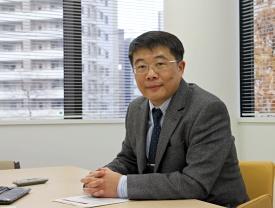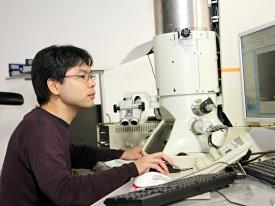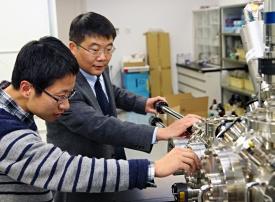

02/28/2011
When asked to describe the toughest challenge facing him in his work, Mingwei Chen, group leader and principal investigator of the Bulk Metallic Glasses Group, does not hesitate in reply: “Bulk metallic glass is an atomic-scale material. We still don’t know how the individual atoms are arranged. Understanding structure at the atomic level is the most important topic in this research,” he says.

First reported in the early 1960s, metallic glasses are a special type of metal alloy that promise to revolutionize the materials industry. Unlike conventional metals, which are produced by allowing the molten metal to cool slowly to afford a material with a well-ordered crystalline structure at the microscopic level, bulk metallic glasses (BMGs) are formed by rapid cooling of the bulk sample such that it solidifies without crystallization. The resulting metals are locked into a disordered ‘liquid-like’ structure, which means that they soften and flow at comparatively low temperatures allowing them to be molded and processed much more easily than conventional metals. At the same time, the irregular, tightly packed internal arrangement of the atoms in BMGs gives them higher density, strength and resistance to wear and corrosion compared to many crystalline metals. Early BMGs had critical cooling rates — the rate of cooling required to create the characteristic amorphous structure — on the order of one million degrees per second. More recent systems, some of which were discovered in the ‘80s and ‘90s at Tohoku University, the home of the WPI-AIMR, have much lower critical cooling rates, although the reasons behind this are still not clear. “Part of our work focuses on some of the most fundamental issues in BMG research, such as the mechanism of BMG formation,” says Chen. “Why, for example, do some alloys have very low critical cooling rates and such good glass-forming ability? This is a big question in this area and we spend a lot of time and effort to understand this issue in my group.”

Another important topic is the question of how BMGs can be plastically deformed. Although BMGs are typically several times stronger than conventional crystalline metals, they are not ductile at normal temperatures and have a tendency to fail abruptly when stretched, with no indication that failure is imminent. This limits their usefulness in load-bearing applications where structural reliability is critical. “Crystalline materials can be plastically deformed by the motion of dislocations — a line of defects in the crystal lattice,” explains Chen. “BMGs are glassy and do not have a crystalline structure, yet we still observe plastic deformation in these systems.” To account for this phenomenon, Chen and his co-workers utilize and develop the theory of shear transformation zones (STZs), nano-sized pockets that undergo plastic deformation resulting in a build-up of stress and the formation of localized shear bands, which can eventually lead to mechanical failure of the BMGs. Examination of a series of different BMG systems using a new technique called ‘rate-jump nanoindentation’ developed at the WPI-AIMR has made it possible to correlate the volume of the atomic clusters involved in the STZs with the ductility of the BMGs. “Unlike conventional metals where we can gain information about the bulk properties of a sample by looking at its microstructure through a microscope, in the case of BMGs we have to examine the structure at the atomic scale in order to understand the material’s bulk mechanical properties. Once we have a clear understanding of this we can begin to design BMG systems with the desired atomic arrangement for improved mechanical properties,” he says.
Getting down to this level of structural detail requires the deployment of cutting-edge experimental techniques such as extended X-ray absorption fine structure spectroscopy, which is carried out using the synchrotron radiation facility at the RIKEN SPring-8 center located at the Harima institute west of Kobe in central western Japan. Closer to home, Chen and his co-workers have also developed an angstrom beam electron diffraction technique using a coherent electron beam with a width of approximately 0.3 nm to observe the arrangement of individual atomic clusters in a BMG sample. The high levels of precision required for the experiment were only possible thanks to a state-of-the-art, custom-made spherical aberration-corrected transmission electron microscope, which was built in collaboration with a major Japanese scientific instrument manufacturer and which incorporates a condenser aperture designed by researchers at the WPI-AIMR. The electron microscope, purchased with strategic funding from the WPI-AIMR, is one of only a handful of such instruments in Japan and has generated interest from other researchers both inside and outside the WPI-AIMR.
Although he considers BMG as his main field and notes its position as one of the mainstays of the work of the WPI-AIMR, Chen is keen to stress that the Advanced Functional Materials Laboratory is concerned with much more than just BMG research. The remit of the section is broad — nanostructured materials, nanocomposites and nanocrystalline metals for high-strength materials are all included in the portfolio, along with research into metal colloids and the theoretical studies and simulations that underpin concepts such as STZs. “We carry out a wide range of research here, but BMG research will always be a key topic for the WPI-AIMR, not just because of its inherent importance but also because Tohoku University has made a special contribution in this area,” says Chen referring to the more than 40-year involvement of the university in the field of BMG research.

A key member of the original committee that proposed and subsequently set up the WPI-AIMR, Chen began his academic career as an associate professor at the prestigious Shanghai Jiaotong University in China before joining the Institute for Materials Research at Tohoku University as a guest researcher from 1997 to 1999. Following a stint in the US where he worked as an associate research professor at Johns Hopkins University, he returned to Sendai in 2003 to join the International Frontier Center for Advanced Materials as one of the first non-Japanese researchers to be hired as a professor at Tohoku University. “One of the reasons I came back to Japan is because the equipment here is so good. Plus the research funding is much more stable than in other countries such as the US,” he says. Chen also cites the strong teamwork ethic in Japan, which sees graduate students working closely with associate, assistant and full professors, as another positive point of working at Japanese institutions such as the WPI-AIMR.
As might be expected for one who has been intimately involved with the WPI-AIMR since its inception, Chen is an enthusiastic supporter of the concept of fusion research being pioneered at the institute. Discoveries made by Chen and his co-workers in the Advanced Functional Materials Laboratory are already being applied in other groups of the WPI-AIMR. Nanoporous metal–ionic liquid composites, for example, which are being developed for electrocatalysis and super capacitors, have their origins in Chen’s laboratory, as do the nanoporous gold catalysts being used in chemical synthesis by the Soft Materials Group. Other products of BMG research are being taken up by microelectromechanical systems (MEMS) researchers in the Devices/Systems Group as materials for micro-mirrors in applications such as virtual retinal displays, virtual keyboards and mobile phone projectors. In addition to these applications, Chen foresees an increased emphasis on the development of functional applications for materials in the arena of green innovation, an endeavor in which fusion research will be even more important. “I come from a background of traditional physical metallurgy, but now I am doing research in so many areas, from physics, chemistry and electrochemistry to energy-storage devices and biosensors. My research team all come from different backgrounds too: applied chemistry, applied physics, mechanics — the lot. Fusion research is absolutely essential for the work of the WPI-AIMR, and when you think about it, we’re actually doing fusion research within my own group,” he says.